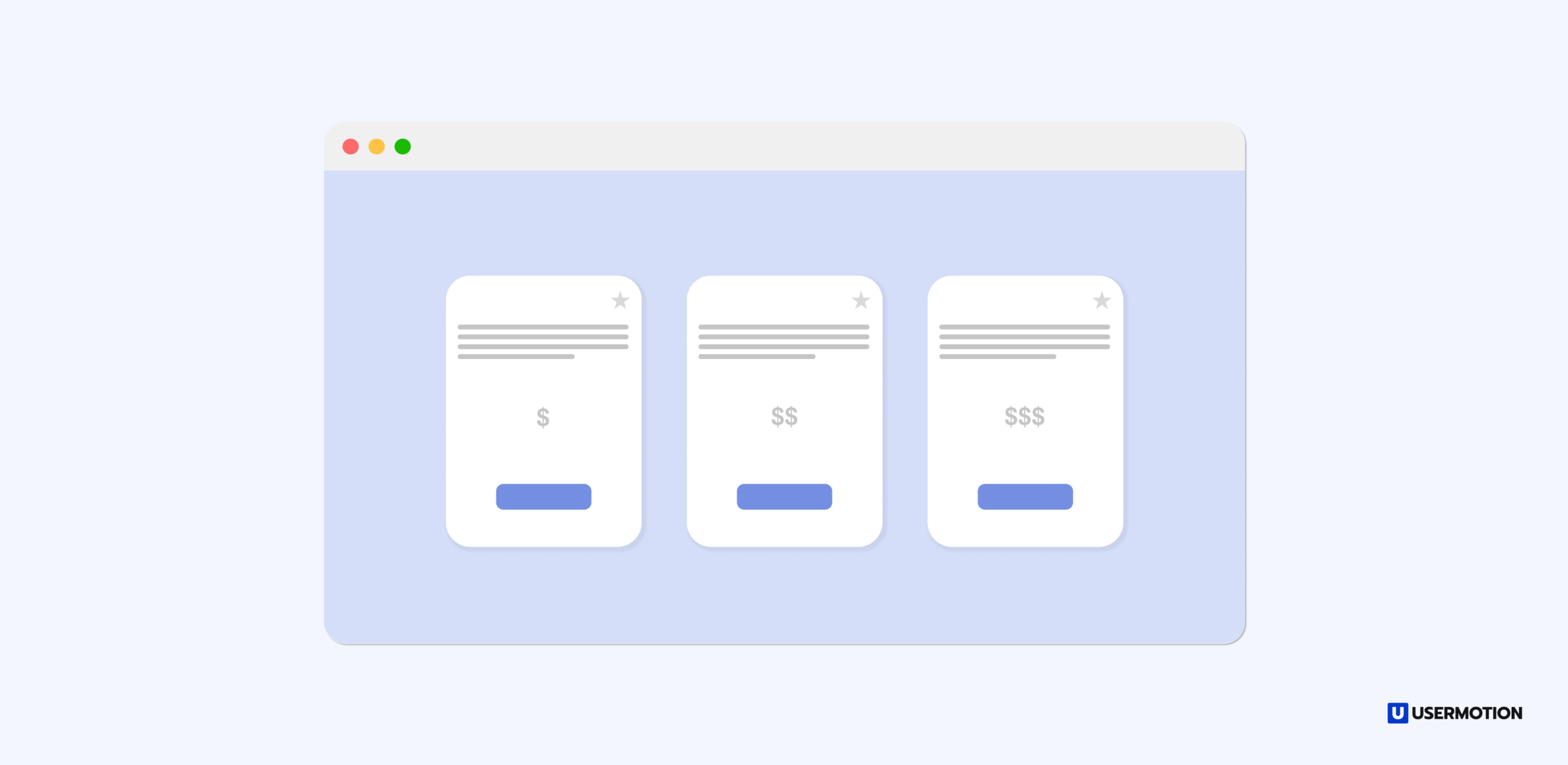I don’t want to spend a single breath elaborating on just how important pricing and packaging are for software, SaaS, and product-led growth (PLG) companies.
But here are two statistics that suffice its gravity:
- 60% of customers consider pricing the first criterion for all buying decisions.
- A 1% improvement in pricing and packaging can result in an 11%+ positive change in gross margins.
The cost of your product matters. And how you present it to the world matters even more.
In this article, we will talk about pricing and packaging for PLG companies. We will also give some examples and use cases about PLG pricing strategies to get maximum conversion while maintaining profitability.
TL;DR
- Pricing and packaging refer to the financial value and presentation of a product’s value to customers.
- For product-led growth (PLG) companies, pricing is crucial in balancing freemium models for customer acquisition and monetization of paid products.
- Effective pricing models for PLG include Usage-based and Seat-based pricing.
- PLG pricing and packaging should be simple, promote account growth, represent perceived value, and preserve profitability.
- Successful PLG pricing plans require constant iteration based on data, trends, and customer input.
What is Pricing and Packaging?
Simply put, pricing is the financial value you put up for your product. Pricing and packaging together is how well you can convey that value to your customers.
In the world of online business and impersonal communication, most buying decisions come down to how optimum the pricing is and how well it is presented to the customers.
This is why it is important to have a clear pricing and packaging strategy that hits the gold standards on value proposition, competitive positioning, and customer perception while being bundled up and communicated most effectively.
Now that we have the basics out of the way, let’s talk about pricing and packaging for PLG companies.
Pricing and Packaging for PLG Companies
For PLG companies, pricing and packaging is a tad more complex, and mostly misunderstood. The minimization of sales representatives of customer-facing teams comes into play heavily here.
Here, pricing and packaging are all about balancing customer acquisition through a freemium model and monetizing the paid product.
According to Kyle Polar of OpenView Ventures, “Pricing is equally as important for PLG companies—although it’s even harder to get right. You have more users, which means you have more room for experimentation but also a bigger magnifying glass if you get it wrong.”
Types of Pricing and Planning Models for PLG Companies
As discussed above, PLG pricing differs from your ordinary SaaS. Since products and free trials spearhead the sales process in a PLG funnel, it’s important to hit the hammer on conversion with the right kind of pricing model that conveys the value of the product without appearing ‘salesy.’
Here are the two most effective pricing models for PLG companies:
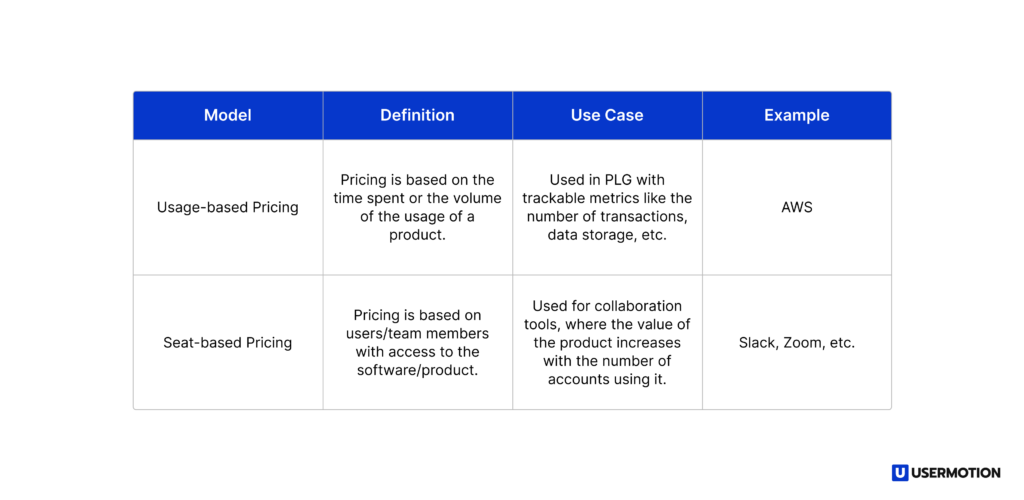
PLG companies choose different ways to decide how much they charge for their products. One way is usage-based pricing. This means the more you use the product, the more you pay. For example, if you use a cloud service like AWS, they charge you based on how much storage you use or how many transactions you make.
Another way is seat-based pricing. In this case, the cost depends on how many people use the product. It’s common with apps that teams use to work together, like Slack or Zoom. The more people on your team who use it, the higher the price. This method is great because as more people use the app, it becomes more valuable for the team.
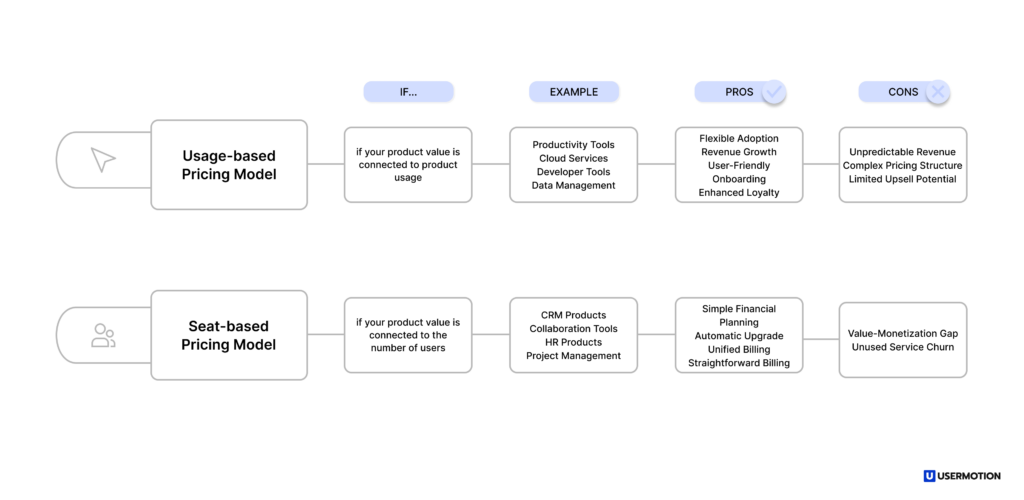
1. Usage-based Pricing
Usage-based pricing lets your customer pay as per their usage of the service. This allows them to start low and scale as they progress.
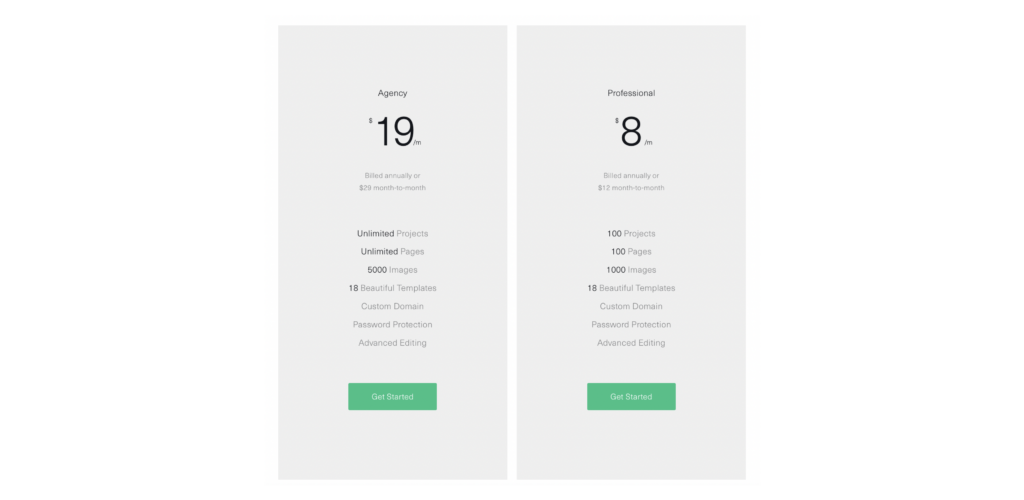
The usage-based pricing is fantastic for PLG companies with a self-serve checkout dashboard. Once your customers and their credit cards are in the system, you can push for upsells or downgrades with minimal effort.
Pros of Usage-based Pricing and Packaging
- Customers are encouraged to try out the product with a low-tier pricing plan and upgrade as they wish.
- A sliding price plan lets huge enterprises and independent users discover a price depending on what they use.
- Usage-based pricing secures a baseline revenue, with chances of capturing additional revenue with increased usage over time. With the right positioning of value and a truly awesome product, there is no limit to the additional revenue that can be unlocked over the years.
- The highlight of having a pay-as-you-go approach is the easy onboarding of price-sensitive users who aren’t ready to commit all the way to the app to bulky plans.
- Charging customers for their limited usage signals that you care for their budgets and are ready to accommodate their profile. This leads to higher customer loyalty that can be monetized over time.
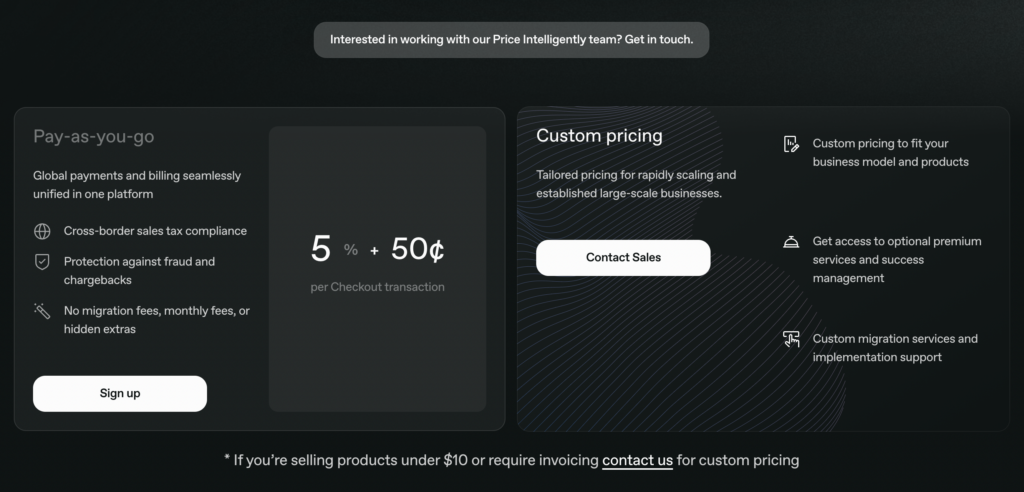
Cons of Usage-based Pricing and Packaging
- It’s harder to predict revenue for the rest of the year, as fluctuations in customer usage can lead to uncertain billing cycles and riskier financial planning.
- Building a pricing plan based on usage is complex, as there are several things that need to be taken into account, such as distinguishable tiers, monitoring usage, and unique billing for each user.
- Offering the product with a lower pricing plan and limited usage can result in plenty of users shying away from committing to the premium plans.
2. Seat-based Pricing
Unlike user-based pricing, seat-based pricing charges customers based on the number of people accessing the service. Each new account using the service is charged, regardless of their usage. This pricing works best for collaborative tools like Canva, Slack, Zoom, etc.
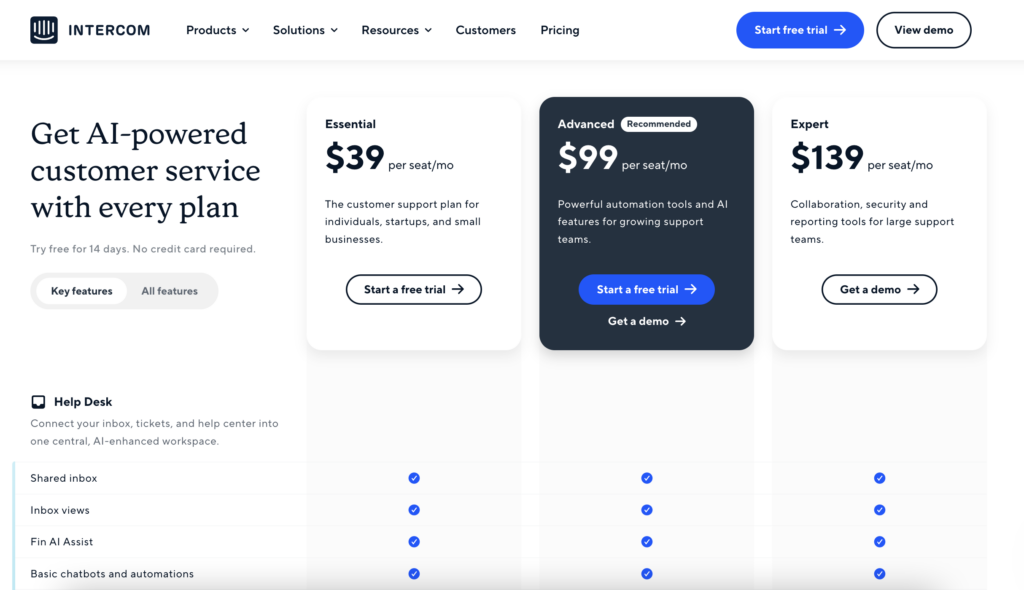
Pros of Seat-based Pricing and Packaging
- Users can easily take budgeting and forecasting into account and make financial plans for the year.
- Since upgrades are tied to users, the widespread adoption of the software will automatically encourage customers to upgrade the product per their team’s needs.
- It’s easier to position and message a unified billing structure that can be communicated effectively by the marketing and sales team.
- A straightforward billing structure with seat-based pricing allows for easier billing that is both easier for the users and for the subscriptions team to handle.
Cons of Seat-based Pricing and Packaging
- You cannot derive a higher value from customers using the service more than its average value per dollar.
- Customers committing to a single plan and realizing that they are paying for the full breadth of service that they aren’t using can cause churn at a higher rate.
Bonus: Hybrid Pricing
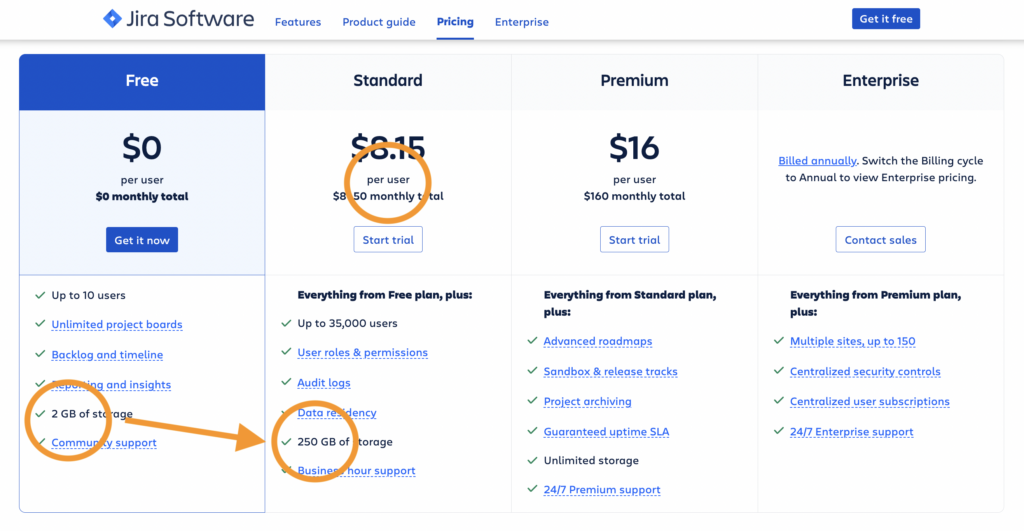
Many PLG companies that offer software as a service offer a diverse range of features and use cases that cannot be boxed on a pay-as-you-go or a pay-as-many-use basis.
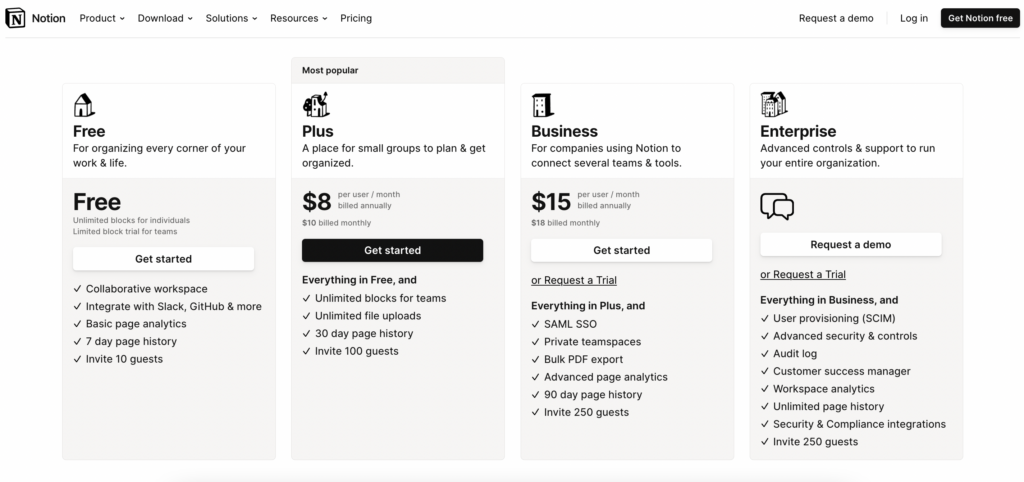
For companies like this, the best option is to create usage-based pricing that accommodates various customer bases, a sliding pay scale, and flexible plans for all users.
How To Nail Pricing and Packaging For PLG
PLG companies are driven by self-serve buyer journeys and freemium models. This makes it easier for PLG to get new users, but it also delays the conversion.
In cases like these, pricing and packaging the set value of the products makes a world of difference in conversion rates. Here are the 4 fundamentals to remember:
1. Keep it simple
PLG sales aren’t limited by complicated price structures, subscription administration, and billing. Keep the process simple to reduce customer and internal team friction.
2. Promote account growth
Effective pricing and packaging should actively expand accounts beyond immediate sales. This requires aligning your price structure with your product’s scalability to encourage people to try new features and services.
3. Present the perceived value
Your price approach should perfectly represent your product’s worth. Communicating your product’s value helps users understand their investment. This boosts client happiness and retention.
4. Focus on Profitability
While fostering account growth and emphasizing value, it is crucial to maintain a focus on profitability. The pricing and packaging model should attract and retain users and contribute to the company’s financial health. Striking the right balance ensures sustained success in a PLG framework.
5. Highlight a “Recommended” Plan
Customers are often overwhelmed with options. PLG companies can provide a “recommended” plan that gives the best value for most consumers. This streamlines the user’s decision-making and gradually leads them toward a strategy that benefits both sides. Make sure that the proposed plan is carefully priced and packaged to balance features, scalability, and affordability.
Conclusion
Getting pricing is incredibly important. As marketing leader Katherine Paine once said, “The moment you make a mistake in pricing, you’re eating into your reputation or your profits.”
But here’s the thing. Nobody gets pricing and packaging right on the first try, and that shouldn’t be your goal either. Your best bet is collecting data, studying trends, and communicating with your customers so you can iterate the pricing and packaging with each new revenue cycle.
Frequently Asked Questions
How is pricing and packaging for PLG companies?
Pricing is the financial value of a product. In contrast, pricing and packaging together refer to how well the value of the product is transferred to customers by product-led growth (PLG) companies. In the unique case of PLG companies, a pricing and packaging strategy considers value proposition, competitive positioning, and customer perception to arrive at a market-fit and profitable price point.
How are pricing and packaging strategies different for PLG companies?
Pricing and packaging for PLG companies rely on a self-serve model that allows users to discover, adopt, and upgrade the product independently. Without a conventional sales team and a freemium model, pricing and packaging is often the single biggest factor that drives conversion.
Why is pricing and packaging for PLG companies considered more complex?
Pricing and packaging for PLG companies is way more complex due to the absence of sales representatives, and the challenge of walking the tightrope of customer acquisition through both freemium models and monetization of the paid product.

